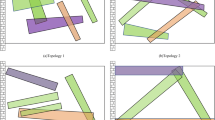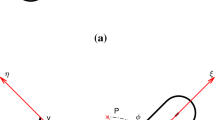Abstract
Currently engineering analysis is regarded as an integrated part of design process and medial axis (MA) is often utilized. However, the generation of MA of complicated models is computation intensive since it is always generated from scratch even if a tiny modification is imposed. A novel local adaptation-based approach to generating the MA for efficient engineering analysis is proposed in this study. With this method, the MA of a resultant model constructed from two other models via a Boolean operation or parameter modification is generated by adapting the MAs of the operand models in a certain way, instead of regenerating the MA from scratch. First, several new properties of the MA which are the fundamental basis of the proposed method are investigated. Then, the boundaries that will vanish from or be added into the resultant model during the Boolean operation or parameter modification are found, and the region in which the MA segments (MASs) need to be regenerated is determined. Finally, the new MASs are generated for the region using an improved tracing method. The final MA of the resultant model is thus constructed by combining the newly generated MASs with the reserved MASs of the operated model(s). Some examples are given to illustrate the high computational efficiency of the proposed method for engineering analysis.



















Similar content being viewed by others
References
Blum H (1967) A transformation for extracting new descriptors of shape. Models for the Perception of Speech and Visual Form. MIT Press, Weinant Wathen-Dunn, pp 362–381
Ramanathan M, Gurumoorthy B (2002) Constructing medial axis transform of planar domains with curved boundaries. Comput Aided Des 35:619–632
Patrikalakis NM, Maekawa T (2002) Shape interrogation for computer aided design and manufacturing. Springer, Berlin
Hesselink WH, Roerdink JBTM (2008) Euclidean skeletons of digital image and volume data in linear time by the integer medial axis transform. IEEE Trans PAMI 30(12):2204–2217
Chin F, Snoeyink J, Wang CA (1999) Finding the medial axis of a simple polygon in linear time. Discret Comput Geom 21:405–420
Held M (2001) VRONI. An engineering approach to the reliable and efficient computation of Voronoi diagrams of points and line segments. Comput Geom 18:95–123
Lee DT (1982) Medial axis transformation of a planar shape. IEEE Pattern Anal Mach Intell 4:363–369
Yap CK (1987) An O(nlogn) algorithm for the Voronoi diagram of a set of simple curve segments. Discret Comput Geom 2:365–393
Aichholzer O, Aigner W, Aurenhammer F et al (2009) Medial axis computation for planar free_form shapes. Comput Aided Des 41:339–349
Nackman LR (1982) Curvature relations in three-dimensional symmetric axes. Comput Graph Image Process 20:43–57
Bookstein FL (1979) The line skeleton. Comput Graph Image Process 11:123–137
Scott GL, Turner SC, Zisserman A (1989) Using a mixed wave diffusion process to elicit the symmetry set. Image Vis Comput 7(1):63–70
Siddiqi K, Bouix S, Tannenbaum A, et al. (1999) The Hamilton-Jacobi skeleton. In: International Conference on Computer Vision (ICCV), pp 828–834
Ragnemalm I (1993) Pattern recognition letters. Pattern Recogn Lett 14(11):883–888
Hoff KE, Keyser J, Lin M, et al (1999) Fast computation of generalized Voronoi diagrams using graphics hardware. Comput Graph 33(Annual Conference Series):277–286
Vleugels J, Overmars M (1995) Approximating generalized Voronoi diagrams in any dimension. Technical Report UU-CS-95-14, Department of computer science, Utrecht University
Foskey M, Lin M, Manocha D (2003) Efficient computation of a simplified MA. In: CD proceedings of the ACM symposium on solid and physical modeling
Montanari U (1969) Continuous skeletons from digitized images. J Assoc Comput Mach 16(4):534–549
Lee DT (1982) MA transformation of a planar shape. IEEE Trans Pattern Anal Mach Intell 4(4):363–369
Srinivasan V, Nackman LR (1987) Voronoi diagram for multiply connect polygonal domains, I: algorithm. IBM J Res Dev 31(3):361–372
Gursoy HN, Patrikalakis NM (1991) Automated interrogation and adaptive subdivision of shape using MA transform. Adv Eng Softw Workstn 13(5/6):287–302
Gursoy HN, Patrikalakis NM (1992) An automated coarse and fine surface mesh generation scheme based on MA transform, part I: algorithms. Eng Comput 8(3):121–137
Gursoy HN, Patrikalakis NM (1992) An automated coarse and fine surface mesh generation scheme based on MA transform, part II: implementation. Eng Comput 8(4):179–196
Culver T, Keyser J, Manocha D (1998) Accurate computation of MA of a polyhedron. Technical Report TR98-034, UNC-Chapel Hill
Choi HI, Choi SW, Han CY et al (2008) Two-dimensional offsets and medial axis transform. Adv Comput Math 28:171–199
Choset H (1997) Incremental construction of the generalized Voronoi diagram, the generalized Voronoi graph, and the hierarchical generalized Voronoi graph. In: 1st CGC workshop on computation geometry
Chiang C-S (1992) The Euclidean distance transform. Ph.D. thesis, Department of Computer Science, Purdue University, West Lafayette, Report CSD-TR 92-050
Sherbrooke EC, Patrikalakis NM, Brisson E (1995) Computation of MA transform of 3-D polyhedral. In: ACM solid modeling, pp 187–199
Reddy JM, Turkiyyah GM (1995) Computation of 3D skeletons using a generalized Delaunay triangulations technique. Comput Aided Des 27(9):677–694
Dutta D, Hoffmann CM (1990) A geometric investigation of the skeleton of CSG objects. UM-MEAM-90-02
Cao L, Jia Z, Liu J (2009) Computation of medial axis and offset curves of curved boundaries in planar domains based on the Cesaro’s approach. Comput Aided Geom Des 26:444–454
Cao T, Tang K, Mohamed A, Tan T (2010) Parallel banding algorithm to compute exact distance transform with the GPU. In: Proceedings of the ACM SIGGRAPH symposium on interactive 3D graphics and games (I3D). New York, 19–21 Feb 2010
Lavender D, Bowyer A, Davenport J et al (1992) Voronoi diagrams of set-theoretic solid models. IEEE Comp Graph Appl 12(5):69–77
Brandt JW (1994) Convergence and continuity criteria for discrete approximations of the continuous planar skeleton. CVGIP: Image Underst 59(1):116–124
Dey TK, Woo H, Zhao W (2003) Approximate MA for CAD models. In: Proceedings of the solid and physical modeling 2003, Seattle, Washington, 16–20 June, 2003
Sheehy DJ, Armstrong CG, Robinson DJ (1996) Numerical computation of medial surface vertices. In: Mullineux G (ed) The mathematics of Surfaces VI. IMA, Oxford University Press, Oxford
Etzion M, Rappoport A (1999) Computing the Voronoi diagram of a 3D polyhedron by separate computation of its symbolic and geometric parts. in W. F. Bronsvoort and D. C. Anderson, editors. In: Proceedings of fifth symposium on solid molid modeling and applications, Ann Arbor, ACM, pp 167–168
Ramamurthy R, Farouki T (1999) Voronoi diagram and medial axis algorithm for planar domains with curved boundaries I: Theoretical foundations. J Comput Appl Math 102:119–141
Joachim G, Balint M, Mark P (2007) Medial axis approximation of planar shapes from union of balls: a simpler and more robust algorithm. In: Canadian Conf. on Computational Geometry, Ottawa, Canada, 20–22 Aug, 2007
Choi HI, Choi SW, Moon HP (1997) Mathematical theory of medial axis transform. Pac J Math 181(1):1997
Acknowledgments
The authors are appreciated for the support from the 863 High-Technology Project of China (No. 2011AA100804), NSF of China (61173126, 91024007, 70901052) and Zhejiang Provincial Natural Science Foundation of China(R1110377).
Author information
Authors and Affiliations
Corresponding author
Rights and permissions
About this article
Cite this article
Liu, Y., Xian, C., Li, M. et al. A local adaptation-based generation method of medial axis for efficient engineering analysis. Engineering with Computers 29, 207–223 (2013). https://doi.org/10.1007/s00366-012-0256-z
Received:
Accepted:
Published:
Issue Date:
DOI: https://doi.org/10.1007/s00366-012-0256-z




